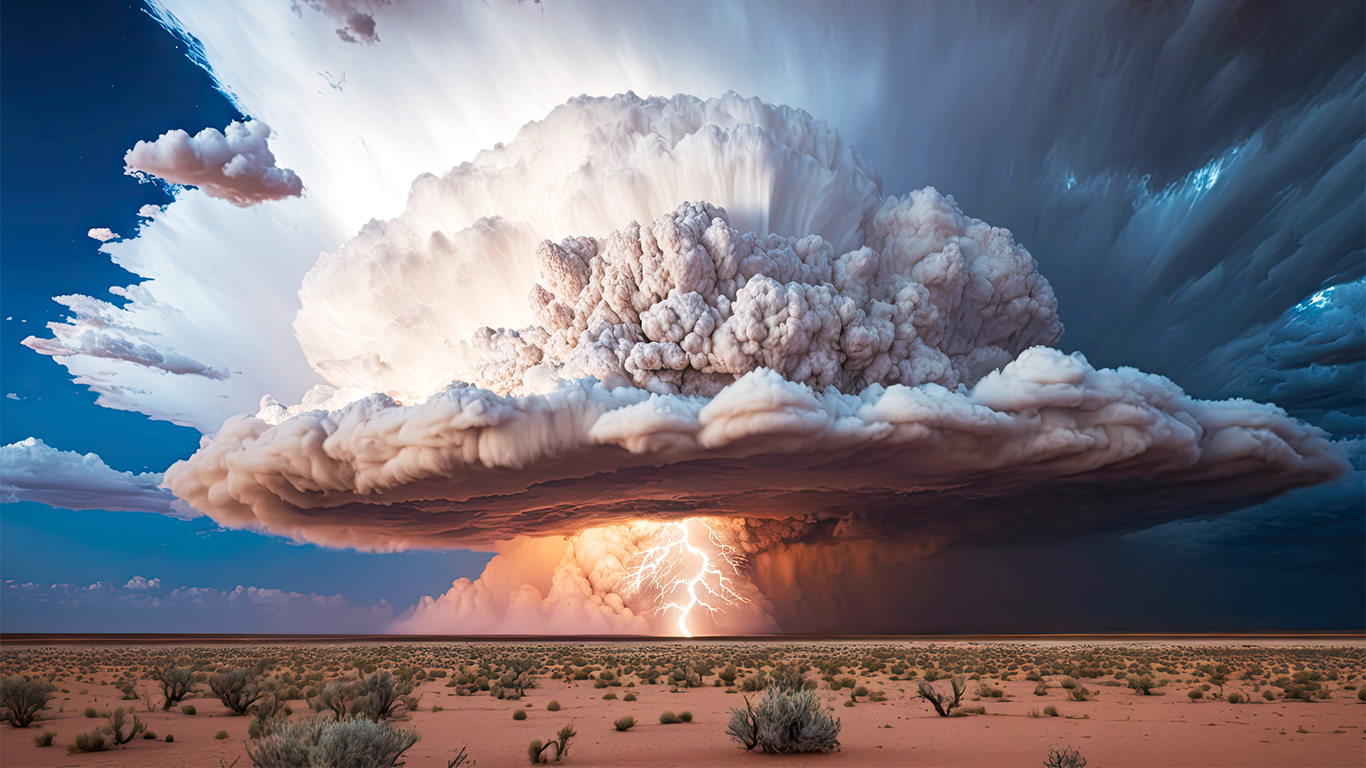Tornadoes and dust storms are powerful natural phenomena that often sweep across the U.S., leaving awe and impact in their wake. Tornadoes, common in the Midwest’s “Tornado Alley,” spin violently with destructive winds, while dust storms, like those in the Southwest, create towering walls of swirling sand and dust. Both remind us of nature’s incredible force, shaping landscapes and communities with their fleeting but fierce presence.
Arizona’s dramatic desert landscapes come with unique weather events, one of the most awe-inspiring and disruptive being dust storms, also known as haboobs. These walls of wind-driven dust can span miles and reduce visibility to zero in minutes. The state’s arid climate and wide-open spaces create perfect conditions for such storms, especially during the monsoon season. Recently, residents in San Tan Valley witnessed a massive dust devil — a swirling column of air resembling a small tornado — crossing the road, captured on camera by a 12News viewer. Though dust devils are generally less intense than haboobs, they still kick up large amounts of dirt and debris, posing both health risks and home maintenance challenges.
Unfortunately, PM2.5 and PM10 (tiny particles found in dust) can linger in the air and aggravate respiratory issues, particularly in those with asthma or COPD. Indoors, dust settles on every available surface, infiltrates HVAC systems, and can compromise indoor air quality for days after the event. For homeowners across Arizona, especially in high-risk areas like Phoenix, Mesa, or Tucson, understanding how to clean your house after a dust storm is a matter of health and comfort. Here are some tips to consider:
LOCAL NEWS: 100 best places to work and live in Arizona for 2025
Breathe Easy: How to Restore Indoor Air Quality
For many Arizonans, the greatest risk after a dust storm isn’t the mess you can see; it’s the particles you can’t. Fine dust infiltrates HVAC systems, vents, and every crack in your home, circulating long after the storm ends. For people with asthma, this can trigger days of discomfort or even emergency room visits. Monsoon season brings elevated asthma risks across Arizona, making proactive air care essential.
The first line of defense is your HVAC filter. After a storm, replace your air filter immediately, even if it’s only been in use for a short time. Dust accumulation blocks airflow and allows more particulates to recirculate. Consider upgrading to a high-efficiency filter rated MERV 13 or higher to trap smaller particles. In addition to central filtration, portable air purifiers make a significant impact, especially in bedrooms and high-traffic living areas. While commercial HEPA units are popular, Arizona State University researchers recently found that DIY air filters called Corsi-Rosenthal boxes outperformed commercial HEPA systems in classroom tests. These homemade filters, built using a box fan and MERV 13 filters, reduced PM2.5 levels by 43.3% and PM10 by 30.6%. They’re affordable, effective, and easy to assemble, making them perfect for households looking for budget-friendly air cleaning. Finally, keep windows closed for at least 24 hours after a storm passes, even if the air looks clear. Dust remains suspended in the air longer than many realize, especially in metro areas with lingering vehicle and construction activity.
Surfaces, Soft Fabrics, and Deep Dusting
Once the air is managed, it’s time to tackle the visible aftermath. Arizona dust storms coat surfaces with a fine layer of grit that clings to countertops, baseboards, and even vertical surfaces like walls. Start by wiping down hard surfaces with a damp microfiber cloth, which traps dust rather than spreading it around. Avoid dry dusters, which can push particles into the air again.
Don’t overlook your upholstery and soft furnishings. Dust settles into fibers quickly, so wash bed linens, throw blankets, and draperies as soon as possible. Any fabrics near open doors or windows should be prioritized. For mattresses and couches, use the upholstery attachment on a vacuum to clean all seams and corners thoroughly. Your floors will likely need the most attention. While brooms may stir up dust, a high-performance Shark vacuum offers superior multi-surface cleaning; case in point, the Shark SV1106 Navigator FreeStyle cordless stick vacuum provides strong suction and lightweight maneuverability on carpets and bare floors, where a double or even triple pass is often necessary after a heavy dust event. Clean under furniture, around vents, and in corners where dust accumulates invisibly. After vacuuming, mop hard floors with a damp mop and a gentle cleaner to remove any lingering film of fine dust.
Don’t Forget the Outdoors: Patios, Gutters, and Prevention
Dust storms don’t just affect the interior of your home; outdoor spaces often take the brunt of the impact. Gutters and drains can quickly clog with windblown debris, reducing their effectiveness during monsoon rains. Take time to clear out leaves, twigs, and sediment from your gutters and downspouts. Neglecting this task can lead to water pooling or even roof damage in the next storm.
On patios and outdoor furniture, use a hose or pressure washer to rinse off dust buildup, and sweep walkways and driveways thoroughly. Outdoor cushions should be shaken out or washed, especially if they were left uncovered during the storm. A key strategy to make cleanup easier in the future is preventative maintenance. Seal up gaps around windows, doors, and attic vents using weatherstripping or caulk to reduce indoor dust intrusion. In our “Recurring House Cleaning” article, we emphasized how routine cleaning and maintenance are essential for healthier living environments and reduce the effort needed after a major weather event. Installing door sweeps and replacing worn window seals can go a long way in keeping your indoor space cleaner year-round. Homeowners may also consider landscaping solutions like gravel beds or windbreaks that reduce dust circulation on their property. Desert-adapted ground cover and well-placed trees or shrubs can help limit the amount of dust that reaches your front door.
Conclusion
Living in Arizona is a study in nature’s beauty, but that also means preparing for its more extreme moments. Dust storms and haboobs are a regular part of desert life, but their occurrences don’t have to overwhelm your home. By improving indoor air quality with efficient filtration systems, giving every surface the attention it deserves, and staying proactive with outdoor maintenance, you can keep your household safe and comfortable long after the dust has settled. Whether it’s a dramatic haboob or a spinning dust devil, the key to recovery is acting quickly and cleaning thoroughly, because in the desert, the next storm is always on the horizon.




